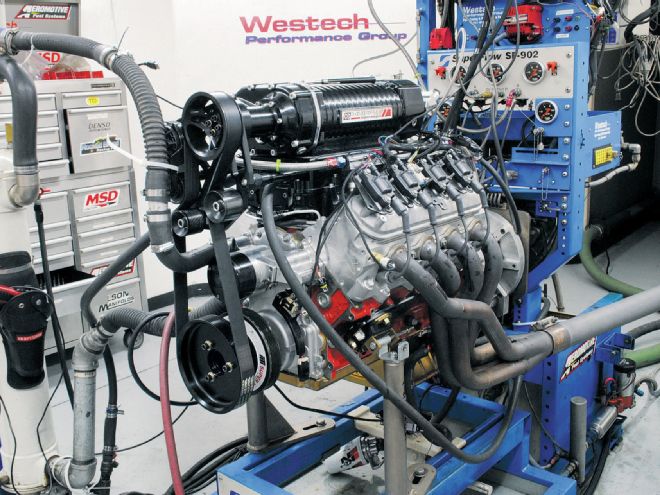
The 4.0L Whipple supercharger and LSX376 B15 crate motor from Chevrolet Performance seemed like a match made in heaven, and we had the dyno sheets to prove it, so why keep going? Does anyone really need more than 900 hp in a street car? Probably not, but just because we managed to exceed 900 hp so quickly doesn't mean we were done with this amazing little crate motor and supercharger combination. We'd like to try turbos or nitrous—maybe both—but a blower is an easier install for the weekend warrior, so we're sticking with this configuration for now and trying to maximize the power potential lurking within all these parts. We don't mind taking things to the next level here at Car Craft. We look at an engine not for what it is, but rather for what it could be, and something many enthusiasts don't realize is that there's a way to make more power with less boost by using a bigger cam.
LS motors (especially the rec-port LS3 variety) respond amazingly well to cam changes because they already sport sufficient displacement, compression, and head flow. Wilder cam timing is all that's needed to complete the performance package, and it's not uncommon for a cam swap to net 60–70 hp on a typical LS3. We were wondering if the same holds true in a boosted application. Luckily, we had the perfect test mule to answer just such a question. This article compares two factory blower cams (LSA and LS9) to a Comp blower cam from Brian Tooley Racing. We also threw in an off-the-shelf, normally aspirated grind that matched the specs of the blower cam but had a much tighter lobe-separation angle (LSA). This comparison would illustrate the difference between cams designed for normally aspirated and supercharged applications. In addition to power and torque, we also monitored boost pressure to illustrate the theory that when it comes to cam timing, you can get more power with less boost. The B15 crate motor was still sporting the 4.0L Whipple twin-screw supercharger, but we dialed it down for this test with the installation of a 4.75-inch blower pulley because there's no need to set things on kill for a simple cam test. This pulley combination dropped boost to a bit more than 16 psi at 6,200 rpm with the LS9 cam supplied with the crate motor.
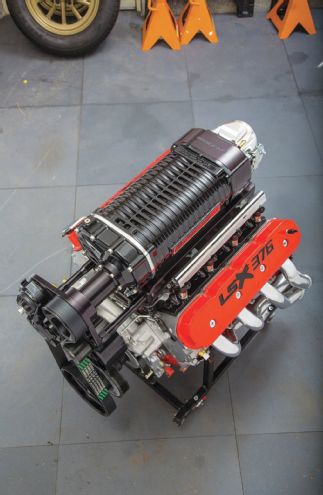
The high-lift blower and NA cams also required upgrading the valvesprings. In addition to the blower cam, Brian Tooley Racing supplied one of its 0.660-lift Platinum spring packages that contained everything needed for the swap, including titanium retainers. The combination was dialed in using a Holley HP EFI system and 83-pound injectors.
Beginning with the LS9 cam supplied with the motor and run through 17⁄8-inch headers from American Racing, the supercharged LSX produced peak numbers of 735 hp at 6,200 rpm and 664 lb-ft at 4,600 rpm. There was more power to be had at higher engine speeds, but we limited the testing to 6,200 rpm, where the supercharger/cam combo produced 16.2 psi.
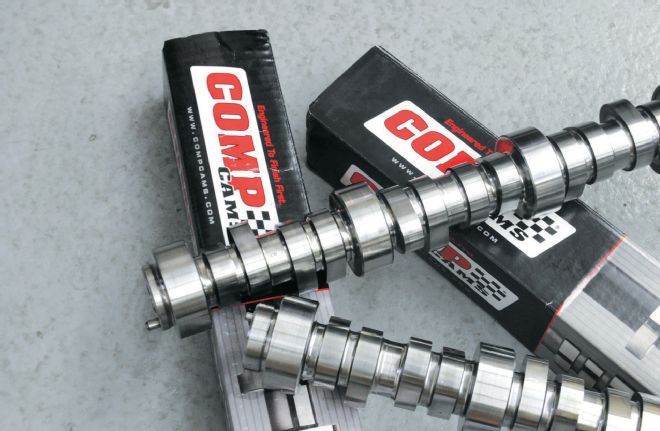
To get a clear picture of what cams had to offer the supercharged LSX376 B15 crate motor, we ran no less than four different cam profiles: two production cams and two from Comp Cams.
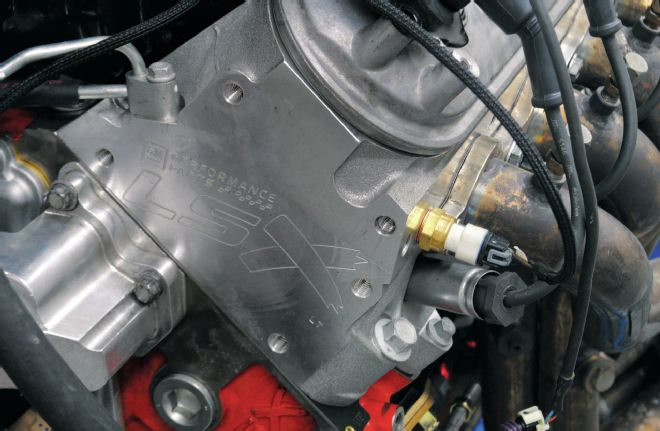
The LS3-based crate motor featured an LSX iron block stuffed with a forged rotating assembly and as-cast LSX heads.
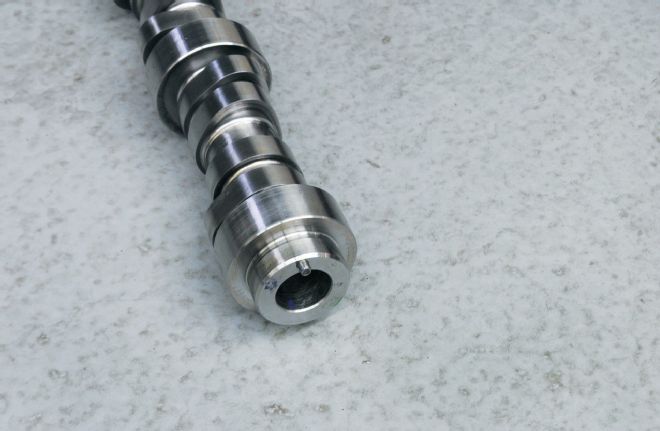
To maximize airflow, the 4.0L Whipple supercharger was configured to accept a 105mm (Ford) Accufab throttle body.
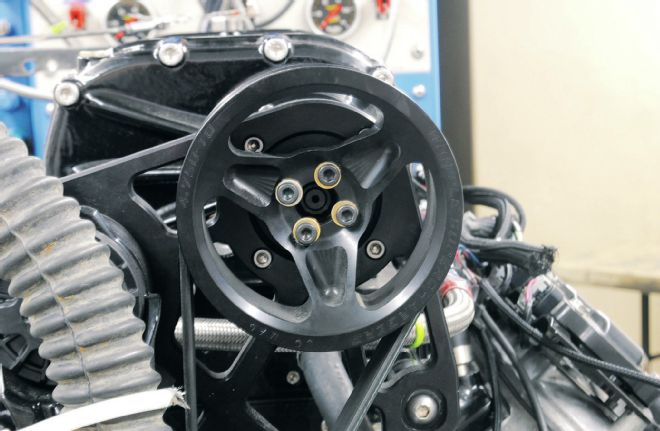
Since we weren’t testing for ultimate horsepower, we installed the largest (4.75-inch) blower pulley in our arsenal to minimize the boost pressure during the cam test. Equipped with this pulley and the LS9 cam, the supercharged LSX produced just over 16 psi at 6,200 rpm (we also limited engine speed).
Next up was the factory LSA cam used in the Cadillac CTS-V and ZL-1 Camaro. Milder than the LS9, the LSA offered 0.480 lift, a 198/216-degree duration split, and wide 122.5-degree LSA. By comparison, the LS9 offered 0.562-inch lift, a longer 211/230-degree duration split, but a similar 122.5-degree LSA. We previously tested the LSA cam against the LS9 on a normally aspirated 5.3L (see July '13 issue) and expected the LSA cam to offer more low-speed power but lose out to the LS9 on top. This is exactly what happened, as the LSA offered slightly more power up to 4,500 rpm, then fell off thereafter. The power numbers for the LSA checked in at 699 hp at 6,200 rpm and 671 lb-ft of torque at a peak boost pressure of 17.4 psi. Equipped with the LSA cam, the boost increased while the power decreased, compared to the LS9. Neither of the factory cams featured any overlap, with the LSA checking in at -38 degrees compared to the -24.5 degrees for the LS9. When tested on the normally aspirated 5.3L, the LS9 (and nearly identical LS7) were the most powerful of all the factory cams.
With the factory stuff run, it was time for the dedicated Comp blower cam from Brian Tooley Racing (BTR), which offered a 0.617/0.595 lift split, a 231/248 duration split, and wide (like the factory cams) 120-degree LSA. Though much more aggressive than the factory offerings, the BTR blower cam offered no overlap (-0.5 degree). The supercharged LSX responded very favorably to the BTR blower cam. Despite the additional lift, 20 degrees more intake and 18 degrees more exhaust duration, the BTR blower cam offered more power everywhere, from 3,200 rpm to 6,200. Peak power with this cam was now up to 768 hp and 683 lb-ft, and the increase in power manifested itself with a drop in boost to 16.1 psi. Though the two produced similar peak boost numbers, the boost curve with the blower cam was down consistently by 0.5 psi compared to the LS9. In comparison with the LSA, the BTR cam offered 69 more horsepower, and remember, that number would increase if we allowed the motor to rev past 6,500 rpm; the relative gains were increasing with engine speed.
The final cam we tested was the off-the-shelf, naturally aspirated cam offered by Comp Cams (PN 54-469-11). It offered a 0.617/0.624-inch lift split, a 231/247-degree duration split, and tighter 113-degree LSA. This combination produced 13 degrees of overlap, which brought the peak boost pressure down to just 14.8 psi. Compared to the LS9, the NA cam offered more power and less boost, with peaks of 758 hp and 681 lb-ft, but it was down (by 10 hp) compared to the dedicated blower cam. The tighter LSA offered more power up to 3,900 rpm and matched the output of the blower cam out to 5,400 rpm, but the blower cam pulled away after that. BTR's blower cam was obviously the hot ticket for this supercharged LSX, but the test showed that even the off-the-shelf NA cam worked pretty well—better than either of the factory offerings. With the cam swap a sure way to make more power with less boost, we now need to take a look at the as-cast cylinder heads. Check back with us when we find out if more head flow equals more power on a supercharged LSX.
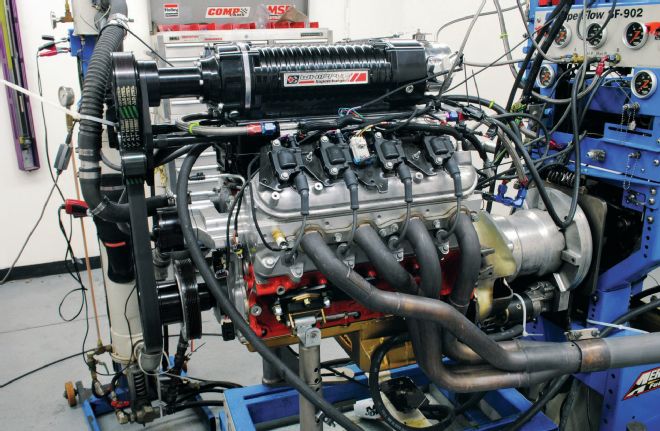
To establish a baseline for the cam test, we first ran the LS9 cam supplied with the crate motor. With a conservative tune that featured 18 degrees of total timing and 16.2 psi, the Chevrolet Performance crate motor produced peak numbers of 735 hp at 6,200 rpm and 664 lb-ft of torque at 4,600 rpm.
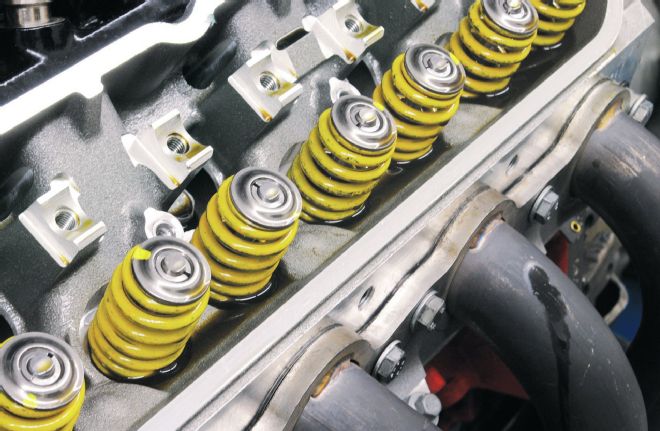
In order to facilitate the high-lift aftermarket cams, it was necessary to swap out the factory valvesprings.
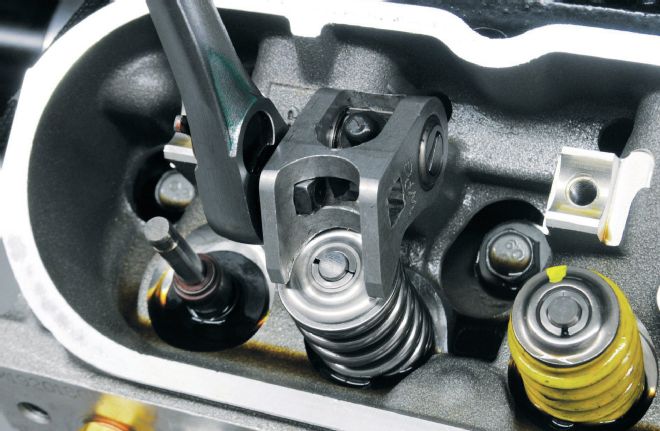
Using the nifty spring compressor, we replaced the stock springs with a dual-spring package supplied by Brian Tooley Racing (BTR). The 0.660-lift Platinum Spring kit included everything needed to replace the factory springs, including titanium retainers, keepers, locators, and seals.
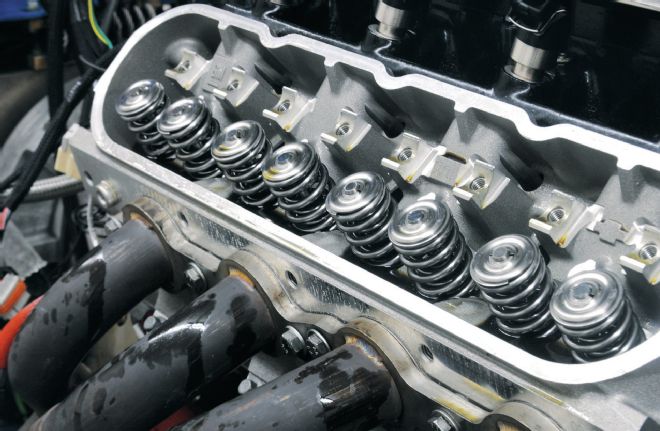
The spring swap went quickly, and soon we were assembled and ready to start swapping cams.

After running the LS9 cam supplied with the crate motor, we decided to install the milder LSA cam. Because the LS9 cam is a common upgrade for factory LSA engines, this showed the power gains offered by the LS9 over the milder LSA on a supercharged application. Note this was a single-bolt design.
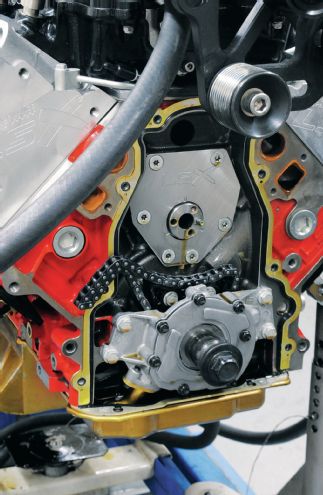
Off came the damper and front cover to allow access to the three-bolt timing gear and cam retaining plate. Note the LSX block featured a dedicated cam retaining plate.
Horsepower, Torque, and Boost Numbers:
LSA LS9 120 LSA 113 LSA RPM HP TQ PSI HP TQ PSI HP TQ PSI HP TQ PSI 3,200 395 648 12.4 390 639 13.2 393 645 12.6 405 665 11.5 3,400 419 647 12.8 412 636 13.7 418 646 13.0 426 659 12.0 3,600 445 649 13.1 440 641 14.1 447 652 13.5 453 661 12.3 3,800 475 657 13.3 469 649 14.4 480 663 13.8 483 667 12.5 4,000 510 669 13.6 504 662 14.6 514 675 14.0 513 674 12.8 4,200 536 670 13.7 530 662 14.6 545 682 14.1 545 681 12.9 4,400 556 664 13.9 555 662 14.8 571 681 14.1 569 679 12.9 4,600 576 658 14.2 582 664 14.8 590 674 14.0 591 674 12.9 4,800 603 660 14.4 606 663 14.9 614 672 14.3 614 672 13.0 5,000 624 656 14.8 631 663 15.1 646 679 14.4 641 674 13.2 5,200 640 646 15.1 652 658 15.1 666 673 14.6 665 671 13.3 5,400 658 640 15.4 669 650 15.2 689 670 14.8 686 668 13.5 5,600 674 632 15.8 689 646 15.3 716 672 14.9 710 666 13.8 5,800 681 617 16.3 705 638 15.6 735 665 15.2 726 658 14.0 6,000 690 604 16.9 718 628 16.0 748 655 15.6 740 648 14.4 6,200 699 593 17.4 735 622 16.2 768 651 16.1 758 642 14.8
The general trend with cam swaps on supercharged applications shows a drop in boost pressure when power increases, assuming no change in the drive ratio. Our results verified this, as the LSA cam offered more power with less boost lower in the rev range than the LS9, but this situation reversed itself past 4,500 rpm. The additional efficiency offered by the cam timing dropped boost pressure, which is nothing more than backpressure in the manifold. The custom Comp blower cam from Brian Tooley Racing continued this trend. When tested, the boost dropped, while the power went up compared to the LS9. Things changed when we installed the tighter LSA Comp cam. The cam offered significantly more power than the LS9 cam (at a lower boost level), but boost and power were down compared to the dedicated blower cam. This is likely the effect of overlap, as the naturally aspirated cam offered 13 degrees of overlap, while none of the other three offered any (–0.5 degrees for the blower cam, –24.5 degrees for the LS9, and –38 degrees for the LSA).
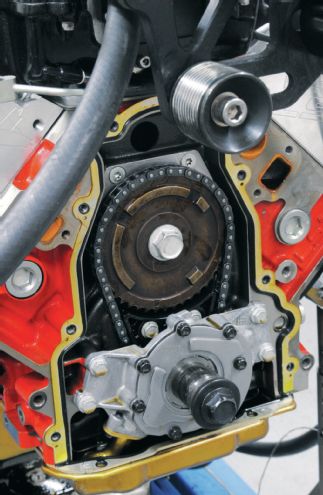
Installation of the LSA cam required a single-bolt (4X) timing gear.
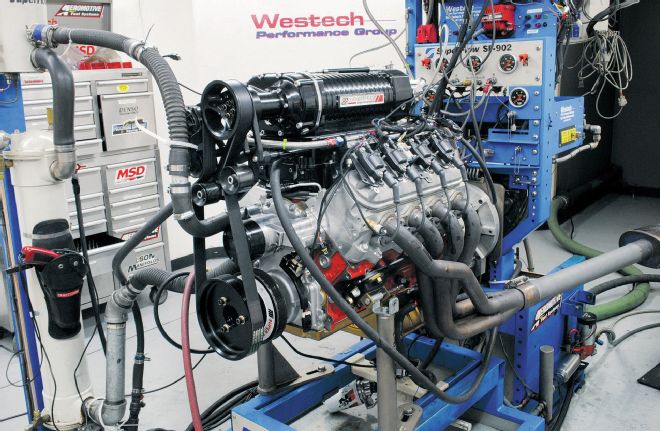
The milder LSA cam offered more power than the LS9 up to 4,500 rpm, but fell off thereafter. The peak numbers checked in at 699 hp at 6,200 rpm and 671 lb-ft of torque at 4,100 rpm, while peak boost increased by 1.2 psi.
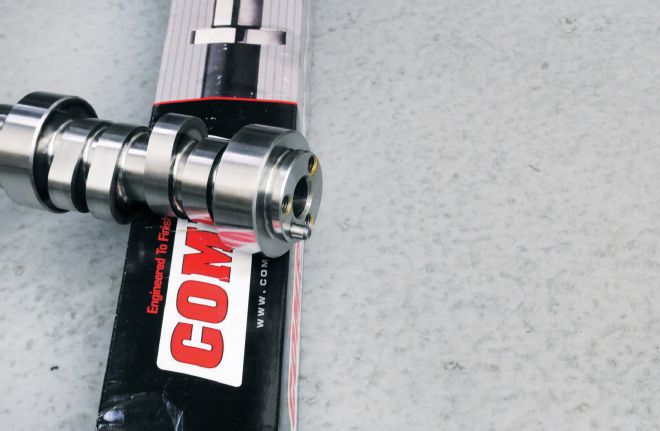
The Stage 3 custom Comp Cam offered by Brian Tooley Racing was designed specifically for positive-displacement superchargers and featured a 0.617/0.595-inch lift split, a 231/248 duration split, and wide (like the factory cams) 120-degree (+5) LSA.
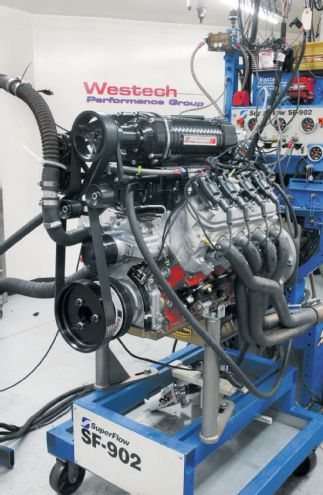
Run with the custom blower cam, the supercharged LSX produced 768 hp at 6,200 rpm and 683 lb-ft at 4,300 rpm. The boost curve dropped by roughly 1⁄2 psi through most of the curve, but the peak boost level was nearly identical to the LS9 cam.
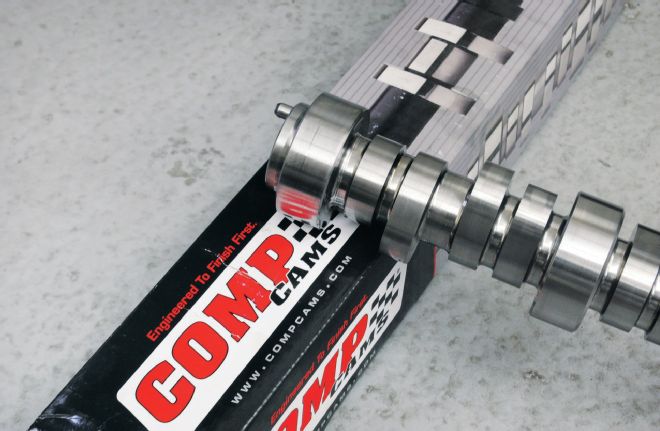
Curious to see how the supercharged motor responded to changes in LSA, we installed one final off-the-shelf cam. Comp’s 54-469-11 offered a 0.617/0.624 lift split, a 231/247-degree duration split, and tighter 113-degree LSA. Compared to the blower cam, this cam—which is better suited to naturally aspirated applications—increased exhaust lift by 0.029 and exhaust duration by 1 degree, but the big change was shifting the LSA by a full 7 degrees.
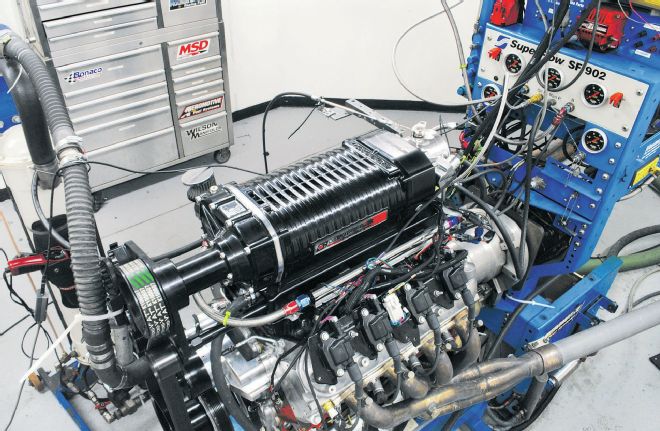
The NA cam offered more power than the LS9, but less than the dedicated blower cam. Boost pressure dropped by more than 1 psi, but peak power numbers checked in at only 758 hp and 681 lb-ft of torque. The tighter LSA increased power down low, but lost out at the top compared to the blower cam.